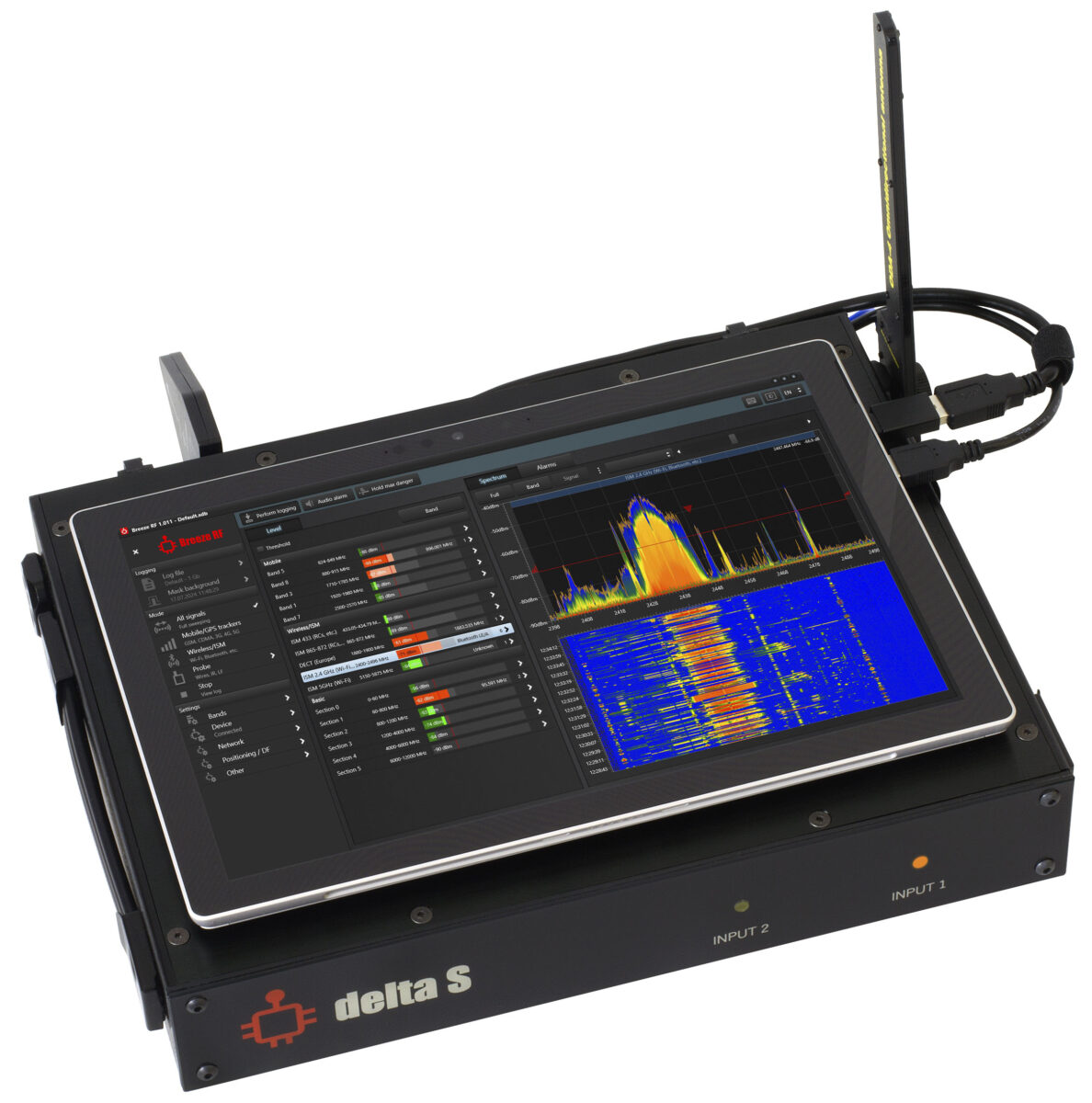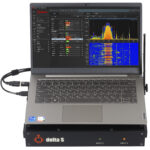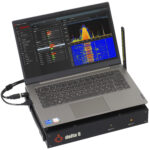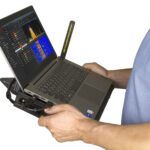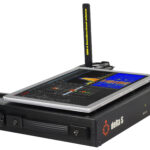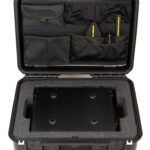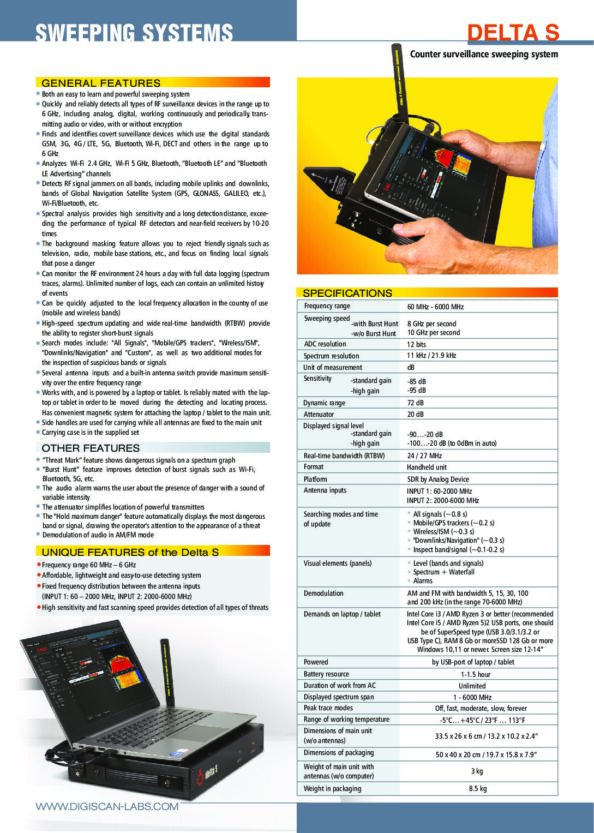- Both an easy to learn and powerful sweeping system
- Quickly and reliably detects all types of RF surveillance devices in the range up to 6 GHz, including analog, digital, working continuously and periodically, transmitting audio or video, with or without encryption
- Finds and identifies covert surveillance devices which use the digital standards GSM, 3G, 4G / LTE, 5G, Bluetooth, Wi-Fi, DECT and others in the range up to 6 GHz
- Analyzes Wi-Fi 2.4 GHz, Wi-Fi 5 GHz, Bluetooth, “Bluetooth LE” and “Bluetooth LE Advertising”
channels - Detects RF signal jammers on all bands, including mobile uplinks and downlinks, bands of Global Navigation Satellite System (GPS, GLONASS, GALILEO, etc.), Wi-Fi/Bluetooth, etc.
- Spectral analysis provides high sensitivity and a long detection distance, exceeding the performance of typical RF detectors and near-field receivers by 10-20 times
- The background masking feature allows you to reject friendly signals such as television, radio, mobile base stations, etc., and focus on finding local signals that pose a danger
- Can monitor the RF environment 24 hours a day with full data logging (spectrum traces, alarms). Unlimited number of logs, each can contain an unlimited history of events
- Can be quickly adjusted to the local frequency allocation in the country of use (mobile and wireless bands)
- High-speed spectrum updating and wide real-time bandwidth (RTBW) provide the ability to register short-burst signals
- Search modes include: “All Signals”, “Mobile/GPS trackers”, “Wireless/ISM”, “Downlinks/Navigation” and “Custom”, as well as two additional modes for the inspection of suspicious bands or signals
- Several antenna inputs and a built-in antenna switch provide maximum sensitivity over the entire frequency range
- Works with, and is powered by, a laptop or tablet. Is reliably mated with the laptop or tablet in order to be moved during the detecting and locating process. Has convenient magnetic system for attaching the laptop / tablet to the main unit.
- Side handles are used for carrying while all antennas are fixed to the main unit
- Carrying case is in the supplied set
Other features
- “Threat Mark” feature shows dangerous signals on a spectrum graph
- “Burst Hunt” feature improves detection of burst signals such as Wi-Fi, Bluetooth, 5G, etc.
- The audio alarm warns the user about the presence of danger with a sound of variable intensity
- The attenuator simplifies location of powerful transmitters
- The “Hold maximum danger” feature automatically displays the most dangerous band or signal, drawing the operator’s attention to the appearance of a threat
- Demodulation of audio in AM/FM mode
Unique features of the Delta S
- Frequency range 60 MHz – 6 GHz
- Affordable, lightweight and easy-to-use detecting system
- Fixed frequency distribution between the antenna inputs (INPUT 1: 60 – 2000 MHz, INPUT 2: 2000-6000 MHz)
- High sensitivity and fast scanning speed provides detection of all types of threats
Specification
| Delta S | |
| Frequency range | 60 MHz – 6000 MHz |
Sweeping speed
|
|
| ADC resolution | 12 bits |
| Spectrum resolution | 11 kHz / 21.9 kHz |
| Unit of measurement | dB |
Sensitivity
|
|
| Dynamic range | 72 dB |
| Attenuator | 20 dB |
Displayed signal level
|
|
| Real-time bandwidth (RTBW) | 24 / 27 MHz |
| Format | Handheld unit |
| Platform | SDR by Analog Device |
| Antenna inputs | INPUT 1: 60-2000 MHz INPUT 2: 2000-6000 MHz |
| Searching modes and time of update |
|
| Visual elements (panels) |
|
| Demodulation | AM and FM with bandwidth 5, 15, 30, 100 and 200 kHz (in the range 70-6000 MHz) |
| Demands on laptop / tablet |
|
| Powered | by USB-port of laptop / tablet |
| Battery resource | 1-1.5 hour |
| Duration of work from AC | Unlimited |
| Displayed spectrum span | 1 – 6000 MHz |
| Peak trace modes | Off, fast, moderate, slow, forever |
| Range of working temperature | -5°C…+45°C / 23°F … 113°F |
| Dimensions of main unit (w/o antennas) | 33.5 x 26 x 6 cm / 13.2 x 10.2 x 2.4” |
| Dimensions of packaging | 50 x 40 x 20 см / 19.7 x 15.8 x 7.9” |
| Weight of main unit with antennas (w/o computer) | 3 kg |
| Weight in packaging | 8.5 kg |
Advantages
Rich selection of search modes
- In the “All signals” mode the system analyzes the spectrum in the full frequency range and detects signals of all types. In addition to mobile and wireless signals, bugging surveillance devices are successfully detected on other frequencies, such as VHF / UHF radio microphones, 900/1200 MHz wireless cameras, and all other RF transmitters up to 6 GHz
- In the “Mobile/GPS trackers” mode the system detects mobile devices of all standards, including GPS beacons (trackers) that are installed on vehicles and transmit coordinates via mobile networks. Quickly and reliably detects embedded devices (hidden cameras and microphones) that transmit information via mobile GSM, 3G, 4G / LTE and 5G networks (up to 6 GHz).
- In the “Wireless/ISM” mode the Delta S quickly detects Wi-Fi, Bluetooth, ZigBee, DECT, LoRa and other radio frequency devices operating on the ISM bands, such as remote controls, smart home components, wireless sensors, etc.
- In the ” Downlinks/Navigation ” mode the system scans the downlink bands of mobile networks and bands of Global Navigation Satellite System. With the active “Detect RF jamming” feature the interferences and anomalies created by RF signal jammers will be detected and displayed on the bargraph. Additionally, a special warning sound will be produced.
Handling of bands
- Information about the RF environment is displayed on the bargraphs, each responsible for a separate frequency band
- By default, the frequency range is divided into several basic bands, in addition to which a number of mobile and wireless bands are added according to the local frequency allocation
- The table of bands can be easily adjusted to the frequency allocation of the country of use
- It is possible to edit and add new bands, including 4G / LTE and 5G in
case of change of frequency allocation Each band has an individual threshold which defines the sensitivity and detection distance - For each band the following information is displayed: name, frequency, current dB level, peak dB level, maximum dB level, threshold, number of dangerous signals and frequency of the most dangerous signal. Additionally, the jammer level is shown when the “Detect RF jamming” feature is active
- The band’s bargraph changes color to red when the threshold is exceeded
- The alarm history for each of the bands is stored in the log and displayed on the graph
- The user can inspect separate bands, view the list of signals in it and perform the location of the transmitter
Automatic recognition of signals
- Signals are automatically recognized in spectral traces, added to the signal list, and then automatically updated
- The list of signals is available in the band’s inspection mode
- The frequency, band, channel, current, peak, and maximum recorded level are displayed for each signal
- The alarm history for each signal is stored in the log and can be displayed on the alarms graph
- The user can proceed to the inspection of a single signal
Masking of background
- The “Mask Background” procedure allows the operator to collect and mask external signals, such as TV signals, radio signals, mobile base stations, etc. and thus, focus on identifying only those transmitters that are located in the target area.
- Background signals are ignored with the help of the spectral mask, which makes it impossible to hide a bugging device within a TV or radio channel
- This procedure is only required for the “All signals” searching mode
- Signals outside of the mobile and wireless bands are subject to masking only
- The duration of measurement can be selected
- Background masking can be performed at several points around the target zone
- Offset of spectral mask (sensitivity) is set by a threshold
Analysis of Wi–Fi and Bluetooth
The level of each active Wi-Fi channel is displayed separately when the bands 2.4 GHz and 5 GHz are inspected. Each channel can be studied individually. Interferences of Bluetooth are rejected
- Levels of Bluetooth, Bluetooth LE and Bluetooth LE Advertising are displayed separately. Each type can be inspected separately. Interferences of Wi-Fi are rejected.
- A list of Wi-Fi access points and not paired BLE devices with their attributes and levels can be displayed in the Devices list and on the spectrum
Threshold and alarm
- Each band has an individual threshold which can be defined by user
- The color of the bargraph changes to red when the threshold level is exceeded
- Signals which exceed the threshold are automatically recognized and stored in the log
- The “Audio alarm” feature warns the operator when the threshold is exceeded. The intensity of the alarm increases as the level rises, which facilitates locating the transmitter
- A full alarm history is stored for each band and signal during the search
- The alarm history of a signal or band can be displayed on the graph for any period
Detecting of RF signal jammers
- Delta S can scan bands where the RF signal jammers may operate – mobile downlinks and bands of Global Navigation Satellite System (GNSS)
- The “Detect RF jamming” feature activates measurement of noise level on all active bands and a special audio alarm
- The feature can be active in all searching modes
- When the presence of an RF signal jammer is discovered, the operator can accomplish finding the source of interference by using the “noise level” bargraph and audio
- In addition to mobile downlinks and GNSS, all other bands can be scanned for the presence of jamming signals
Supplied set
| Item | Delta S |
| Main unit Delta S | 1 |
| Carry case | 1 |
| USB drive with software and user manual | 1 |
| Omni-directed wideband antenna ODA-4 | 1 |
| Microwave antenna MWA-6 | 1 |
| Microwave antenna LPDA-12 | 1 |
| Set of accessories (adapter USB type C – USB type A – 2; magnetic sticker for laptop or tablet – 4) | 1 |


